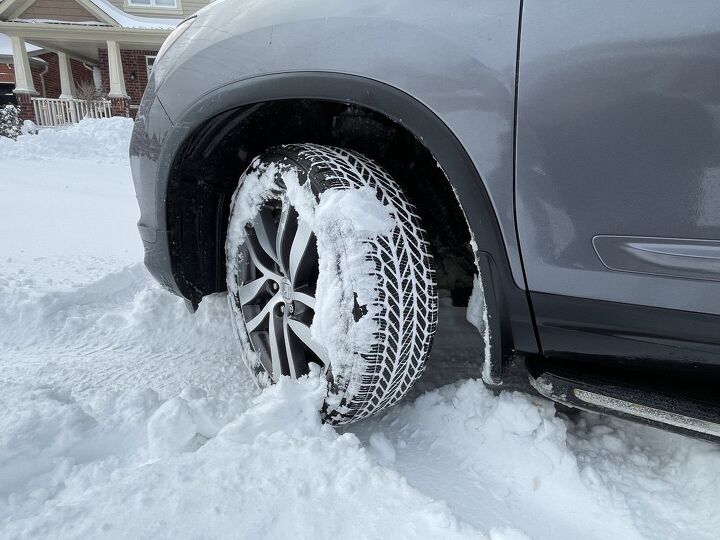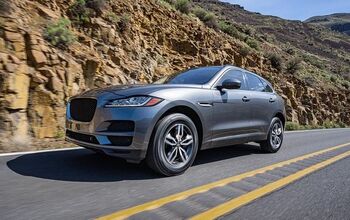Bridgestone WeatherPeak Review


Long-Term Testing of Bridgestone's All-Weather Tire
As the garage door rises from the floor revealing just how much snow has fallen overnight my first thought is how bad my back is going to feel after I finish shoveling. My second thought is if I’m about to regret my all-weather tires.
The concept of all-weather (not all-season) tires isn’t a new one, but it’s surging in popularity right now.
What Are All-Weather Tires?

Before we go any further, it’s important to dig into the distinction I just made. All-weather tires, sometimes called four-season tires, are not, I repeat NOT, all-season tires. For decades all-season tires have been the most popular tires on the road, and their name has always been a gross exaggeration - if not a downright lie.
All-season tires are not good in all-seasons, at least not if you live anywhere that has true seasonal change. And they’re definitely not ok if you live somewhere that has a real winter with plenty of snow and ultra-cold temperatures.
All-weather tires, on the other hand, are built to actually handle every season - yes, including winter. And yes, with snow.
And as proof, they come stamped on the sidewall with the very same three-peak mountain snowflake symbol you find on proper winter tires. This indicates they meet a minimum threshold set by the U.S. Tire Manufacturers Association (USTMA) and the Rubber Association of Canada (RAC) for winter capability. It’s important to point out that this is only a minimum threshold and that there’s plenty of room for more- and less-capable tires within that spectrum.
Real World Testing

Cut back to me, standing in my garage and staring at the thick dump of snow from the night before and you’ll forgive me for my worries. You see, I’ve tested all-weather tires before, with varying results.
More popular in Europe, I tested some from a relatively unknown brand a solid 15 years ago. They were not good. There was no real grip in the snow. OK grip on cold roads. Sloppy handling in the summer.
Would these Bridgestones be any different?
In a word: yes.

After clearing much of the driveway I drove my Honda Pilot out into the deep snow on the road. To my surprise, it didn’t hesitate.
Eager to test the grip of these tires without any momentum behind them, I shifted into park, before getting going again. There was some wheel slip, but no more than anticipated. And in this much snow, even true winter tires will slip.
Getting to the end of my street, the plow had been around the main roads and had built a several-foot-high snowbank blocking me in. Rather than just plow through it, using the weight and momentum of the vehicle, I slowly crept into it and stopped. Then, with some throttle, the tires found traction and pulled me through. Impressive!

The Pilot comes with a snow mode, which reduces throttle inputs to minimize slipping in the real world. I could have used it… but it wasn’t necessary.
Once up to speed the tires (and the weight of the vehicle) allow it to move easily on snow-covered roads. There’s slightly more lateral movement in the ruts than you might find in a dedicated winter tire, but not by much.
I should add in here that the tires come with full-depth sipes - similar to most true winter tires. These work to trap the snow against the tire, using that snow as a traction point for the snow on the road. What this means is that the tires should retain their high level of winter grip over the course of their life. (As I head into the second winter of testing, I should find out soon).

While grip during the big snow storms is important, it’s not the only thing you need from a tire in the winter. It’s important that it also grips in the cold - those times when you don’t expect it to be slippery, but the lower mercury just means it is.
Here I was similarly impressed. There was no loss of grip when accelerating or cornering moderately. Hard braking also brought positive results, with lots of immediate slowing power.
In Bridgestone’s independent testing the tire stopped 30 feet shorter than a conventional all-season tire (the Michelin Primacy Tour A/S). I didn’t do any comparative testing of this sort, but it wouldn’t surprise me if this was extremely accurate.
Testing During the Other Seasons

So the Bridgestone WeatherPeak checks the box for winter performance. And while that’s arguably its biggest test, it’s far from the only thing you need from a tire that’s designed to perform in every season.
Testing the rest of the year showed admirable capabilities. For a larger family hauler the Pilot handles moderately and there was certainly no loss of grip, from turn-in to cornering. Wet traction was also solid in acceleration, braking and cornering.
Of note, so many of these all-weather tires use a unique v-shaped tread pattern. The Weathertech does not. And there appears to be no drawback or specific benefit to it (although I do touch on a curious ponderous characteristic later on in this review).

So far tread life has been excellent. I’ve put a solid 10,000 miles on them and they are not showing any age in either visual appearance or grip.
Tread noise is perhaps slightly higher than a conventional all-season, due in part to the siping. They are still very quiet though and any increase in noise isn’t something you’d even notice on the highway.
Slightly more obvious is that in the summer heat you can essentially hear the tires sticking to the ground when performing tight turns in parking lots and other spaces. It’s hard to describe the exact sound, but it’s definitely there. (Chances are you’ll have your windows up and the A/C pumping so it’s not like you’ll hear this sound anyway).
Down Sides

Those tiny comments on tread noise aside, there must be some actual drawbacks to a tire like this, right? Well, there are, but none are very significant.
First up, there’s the obvious: price and tread life. You’ll pay a bit of a premium for these tires over a conventional all-season. Keep in mind that as a Bridgestone you’ll already be paying for a more premium tire anyway, so you can’t really compare these to a budget all-season.
Second, there’s the tread life. Bridgestone gives the tire a 70,000 mile tread life warranty, which, if you’ve done your research on tires, isn’t really a warranty but more of an expected life. That number sounds impressive, but all-season tires have come a long way lately and 80,000 miles (or more) is the norm now. So you’ll be paying a bit more, for a bit less tire life.

To put that into perspective, however, it’s important to remember that you won’t have to worry about swapping tires twice a year, or storing them, both of which can cost time and money.
About the only other critique I have is a strange one. The tires tend to be more ponderous (quite ponderous in fact) on certain stretches of highway. And I can be extremely specific here: A toll road where I live uses concrete and features a scraped look, as though a rake has been dragged through it. I’ve seen this feature most commonly on freeways in the Southern California area. On these stretches of road the tires pull the car quite a bit causing plenty of steering corrections. I don’t use this road a lot, but if you have similar roads near you that you use all the time, I’d say the “pulling” is dramatic enough that you might want to avoid these tires.
The issue is certainly a strange one, as I’ve never experienced it in this car, either on all-seasons or even on dedicated winter tires - which seems to rule out that it’s related to the added flex of the tread blocks. Either way, it’s strange.
The Verdict

So are the WeatherPeak tires any good? Absolutely!
Do they live up to the promise of being a true all year tire, even in climates with severe winter weather. Again, yes.
Having made a few road trips over the winter to visit my in-laws, the tires became a bit of a conversation piece. My in-laws noticed because I wasn’t rocking the usual winter steelies and they assumed I still had my all-seasons on… I did not.
We got talking and after plenty of questions, the gospel of all-weather tires might just have a few more believers come next winter.
I’m genuinely impressed with these tires. The cost is on the high side, but it’s most certainly worth not having to think about swapping tires twice a year.
Consider me a convert.
Become an AutoGuide insider. Get the latest from the automotive world first by subscribing to our newsletter here.
Pros | Cons |
|---|---|
True winter/snow capability | Slightly shorter tread life |
Extremely livable the rest of the year | Slightly more premium price |
No need to swap tires/wheels twice a year | Ponderous on “scraped” concrete highways |

With AutoGuide from its launch, Colum previously acted as Editor-in-Chief of Modified Luxury & Exotics magazine where he became a certifiable car snob driving supercars like the Koenigsegg CCX and racing down the autobahn in anything over 500 hp. Find Colum on <a href="http://www.google.com">Twitter.</a>
More by Colum Wood































Comments
Join the conversation